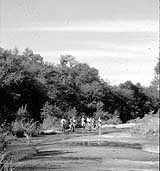
| ch. 5, pp. 60 - 62 |
A final obstacle is that mines are concerned about the spread of polluted water. By pumping groundwater mines have created a cone of depression that confines polluted water to the area near the mines. Mining in TAMA is projected to remain at approximately the current level into the near future, and total water use is estimated to increase slightly to 47,500 acre-feet per year by 2025. The level of future production and water use in the mining sector, however, is difficult to predict. The health of the mining sector is highly dependent on the fluctuating price of copper and molybdenum and advances in mining technology. Proven reserves at Cyprus Sierrita are reported to be 20 years at current production levels and extraction technology. Producers continue to add to capacity, such as the expansion at Silver Bell Mine, but water use efficiency also is increasing. Sand and Gravel Facilities The approximately 15 sand and gravel facilities operating in TAMA used 5,176 acre-feet of groundwater in 1995. This is projected to increase to 7,000 acre-feet per year by 2025. Most sand and gravel facilities recycle much of the water used for washing mined stream deposits. Facilities can save additional water by reducing water use for dust control and other clean-up related activities. Sand and gravel facilities could theoretically use CAP water, effluent or poor quality groundwater. Secondary effluent could be an inexpensive and feasible alternate supply. Because sand and gravel operations are able to pump groundwater at relatively low cost, switching to CAP water would not be economical without a subsidy. Other Industrial Uses Other industrial uses include water for electric power generation and dairy facilities. In 1995, the electric power industry used 1,609 acre-feet, and the only remaining dairy in TAMA used 73 acre-feet in 1995. Since little power is generated locally, electrical usage is not expected to go up over time. Other miscellaneous industrial users consumed 4,026 acre- feet in 1995. Cooling towers and large-scale power plants may be able to switch to effluent. RIPARIAN AREAS AND WILDLIFE HABITAT For many years official studies did not recognize wildlife habitat or riparian vegetation as a legitimate use of water. Diversion from streambeds is what counted, whether for use by humans, cattle or to irrigate crops. The Santa Cruz River through Tucson once had enough water to support cottonwood-willow forests and bosques of giant mesquite that provided habitat for creatures such as muskrats, beaver, edible fish and wild turkey. All of these creatures are gone from the area today, as are most of the riparian forests. Human demand for water outweighed the values of flowing streams and riparian habitat. In recent years, however, this attitude has begun to change. Proposals have been made to allocate a certain percentage of CAP water for establishing some riparian vegetation along the Santa Cruz River, Rillito Creek and Cañada del Oro Wash.
Riparian Water Needs A riparian area in our desert environment needs a reliable supply of water year round (base flow), and it needs occasional spring floods. The base flow may sometimes be just below the surface. Spring floods are needed so that seeds can germinate in the moist soil, then begin to extend their roots downward as the flood waters recede. Even in a natural system, spring floods don’t always set the stage for young trees to get started. In an artificial environment, such as the area along the Santa Cruz River through Tucson, even if trees do get started, they may not have enough base flow to support their continued growth. If the groundwater is at the surface, a variety of wetland plants might grow, such as cattails or rushes. As the water table drops, plants needing constant water are the first to die. Shrubs and trees can survive in areas where groundwater is available down to ten feet below the surface. Mesquite can survive in desert areas without a constant supply of water to the roots, but they grow into very large trees in areas where their roots can reach groundwater. Large mature trees have roots that can go down more than 50 feet to reach water. If the water table is so far below the surface that roots cannot reach water, the plants may still be able to survive if water is available from other sources such as wastewater from a treatment plant. Downstream of Nogales, for example, a rich riparian area survives on effluent from the Nogales International Wastewater Treatment Plant. The effluent provides the base flow that groundwater would have provided and normal variations in rainfall provide the spring floods needed for seedlings. CAP water could also augment flood water in this way. Riparian Vegetation Water Use
Quantifying how much water is used by riparian vegetation is difficult. A mature cottonwood tree can use a lot of water in the growing season, but uses very little when leaves fall in the winter. As a result some people argue that if cottonwood forests were cut down along streams such as the San Pedro, more water would be available for human use. Others counter that this is only partly accurate, because trees and other vegetation perform important functions, some of which actually help to conserve water in the region. For example, the roots of the riparian vegetation hold soil in place, helping to control erosion. Vegetation slows rushing flood waters so that more water remains in the immediate area for recharge. Finally, vegetation provides shade, keeping the water temperature lower than would be the case in the blazing sun, reducing evaporation. The overall impact of tree removal on water resources available for human use is a debated issue, in need of further research.
|


